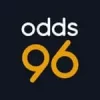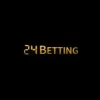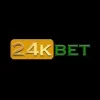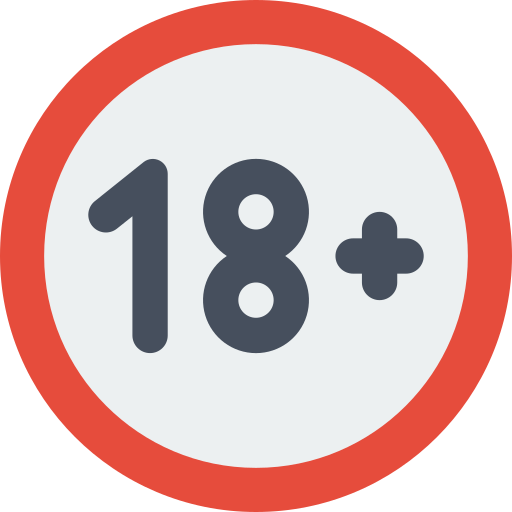Blackjack is one of the oldest casino table games one can think of. It was around the 60’s decade that Blackjack players devised a card counting system that enabled them to gain a house edge. As soon as this was made public, Blackjack players started to beat the dealers successfully in every other game. The game quickly gathered attention after few portals made it online.
Today many users want to know the Blackjack strategy of winning the game. But before that everyone should also have a basic knowledge of the game. Very soon the conditions were amended and casinos started offering Blackjack games where tables used more than one card deck at a time. In some places, the percentage of the cards was cut before dealing. This was done so that players could neither see the cards nor count them.
Not every other player was an expert at playing Blackjack but the belief that one could beat the dealer intrigued players to try their luck. Even after years, Blackjack continues to be one of the choicest casino games across the world. In the US too, Blackjack gained more popularity over other casino games such as Roulette, Craps, and Baccarat. Blackjack is also known as 21 with simple rules.
It does require a certain level of skill which can be attained through practice. Blackjack is a thrilling table game and loved by players who enjoy engaging in strategy. If you are good with numbers and skilled at card counting cards, you can seize several winning opportunities.
Blackjack Rules
As you start, your sole objective of the game is to beat the dealer. You can beat the dealer in various ways. Firstly, if you draw a hand value that is higher than that of the dealer’s, you know that you have beaten him. In the second case, if your hand value exceeds 21 after the dealer draws the cards. Thirdly, you beat the dealer upon drawing a hand value of 21 on the first two cards in your hand at a time when the dealer fails to do so.
You will lose a Blackjack game when if your hand value exceeds 21 or if the dealer’s hand has a higher value than yours at the end of that round.
When playing Blackjack you must pay close attention to a few things. For instance, unlike in a game of Poker where you win could depend on the cards of fellow players, as per Blackjack rules, your opponent’s hands at the table have no role to play in your winning. Blackjack is a pure battle between you against the dealer. There’s no team role despite the number of players sitting at the table.
How to play Blackjack Game
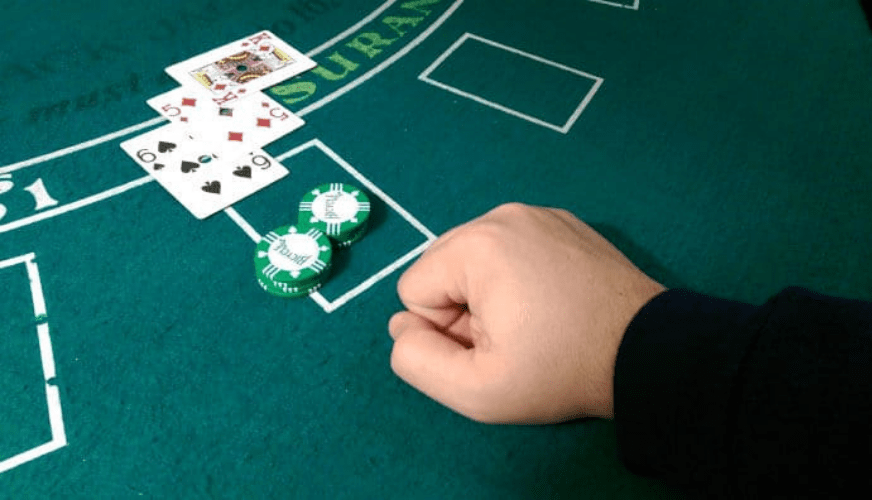
There are quite a few Blackjack variants and each has distinct rules and is played with different numbers of cards decks. Out of all the variants that you see, one of the most common is that dealt out of 6 or 8 decks. These cards are kept in a card dispensing device called the “shoe”.
The most common Blackjack format played is that with 6 decks although single and double-deck games are also played but not as common as the shoe games.
Chips to play with
When you sit to play Blackjack, you need chips to play with. At very few casinos can you wager with cash and so in other casinos, you will have to get the cash you want to stake exchanged for playing coins or casino chips. So, even when you play real money games, you use these as tokens at the table against the real money you want to bet. Remember, that the dealer doesn’t take the money, so don’t hand it over to him or her.
There are certain norms at casinos and for security reasons, any exchange of money between the player and dealer is considered against the casino’s policy.
You can put your money on the felt of the table you intend to play your Blackjack game at and the dealer makes sure that the in-house cameras capture this process. A pit boss comes over to the table and verifies the amount you offer to be staked. Subsequently, the dealer counts out the chip denominations and handovers the chips equivalent to it. You can place your bets as you wish.
Wagering on Blackjack
Before you begin playing, the first step would be to place a bet. Most Blackjack tables display the betting limits on one side of the table depending on which you can place your wager. The betting limits can vary across casinos.
Dealing the cards
Once you’ve placed a bet, the dealer starts dealing the cards. This is done in a clockwise pattern. Every player is given one face-up card. The dealer keeps one card for himself that is face down. In the second deal, he distributes another face-up card to each player and keeps one for himself which is also face up. It’s from here that the game commences.
Playing the hands
When beginning to play, it’s the player seated on the left of the dealer who starts. To play the hand, the player will add the card values in his hand to get a hand total between 4 and 21. If you, fortunately, received a 10 card value along with an Ace as the first two cards, you can call it a Blackjack.
Hence, you don’t have to wait for the round to get over unless of course if the dealer also has a Blackjack. You can get paid 1.5x your wager upon winning the round instantly. However, if the dealer also has a Blackjack, your neither win nor lose.
What happens when neither you nor the dealer has a Blackjack?
If you don’t have a Blackjack and the dealer also doesn’t have one, the dealer points to the other players in succession. By this time you can take a call on how you wish to play your hand. Once it’s your turn, you can decide and signal the dealer accordingly.
Here are the ways you can play your hand:
Stand, Hit, Double Down, Split or Surrender. We’ve explained these options for your comprehensive understanding.
Stand
You can stand if the first two cards in your hand are acceptable. At this point, the dealer signals the next player to play. If you wish to Stand, you will have to wave your hand or put an open palm over the left.
Hit
You can choose this option if you want to want to see how you can improve your hand total with newer cards. This is done one at a time until you choose to stand or you go bust with cards totaling beyond 21. You can take as many cards until it goes beyond 21. Choosing to Hit can be signaled by tapping the felt with your finger.
Double Down
Let’s say you have a hand total that appears advantageous but you feel that you need to add one card still to arrive at a win. In such a case, you can double your original wager and get the dealer to deal one extra card to you. This can be signaled by simply putting a wager that’s equal to your first wager.
Put this on the left side of your initial bet and the dealer will deal an additional card to you. You might see the dealer turning it sideways to indicate that you may not take any more cards.
You can also double for less at some casinos where you don’t have to match the first wager. Experts suggest that this might not be a lucrative option.
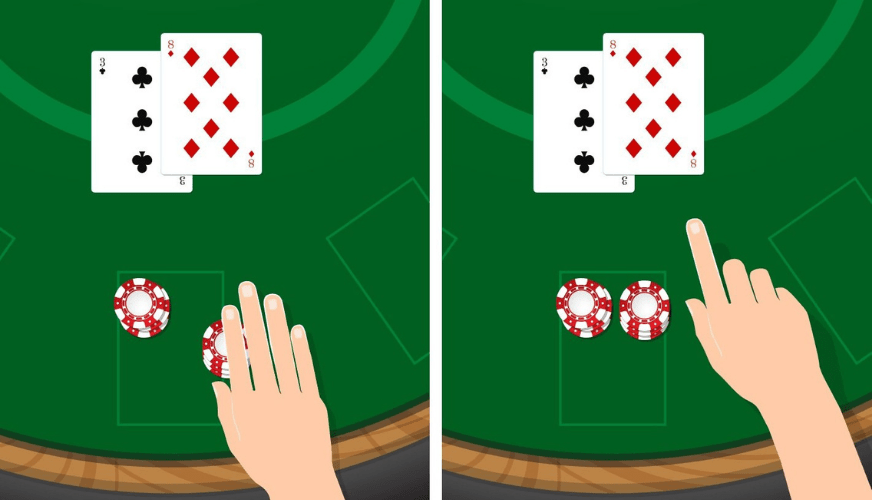
Split
Let’s say you’ve been dealt a pair of cards where each card has an equal value. Now, if you can put a second bet, this deal will split the cards so that each of these cards is seen as first cards on both new hands. So, if you have a hand with a K and J, you can split as both have the same value 10.
If you want to split, simply put a second wager equal to your initial one and give a peace signal to the dealer. The dealer will know that you wish to split and bot double down and will subsequently make hands out of your first one. He will then deal another new card for each of those.
Surrender
Draw a line across the felt just behind your wager to indicate that you want to surrender. You can do this if you don’t like the first hand and think it’s best to give up in exchange for 50% of your original bet.
Dealer’s play
Beyond the 5 ways, as sighted for playing Blackjack, the dealer can play his hand. Depending on his up card he can call it a Blackjack or lose it to the player.
Blackjack Card Values
A quintessential game, Blackjack is played with a standard deck of 52 playing cards. While the suits don’t have a role, cards from 2 to 10 are taken at face value. This means card numbered 2 counts as two points and 10 counts as ten points. Some other cards such as Jack, Queen, and King are counted as 10. Ace can either count as 1 point or 11 points based on how you place and count it to benefit your hand the most.
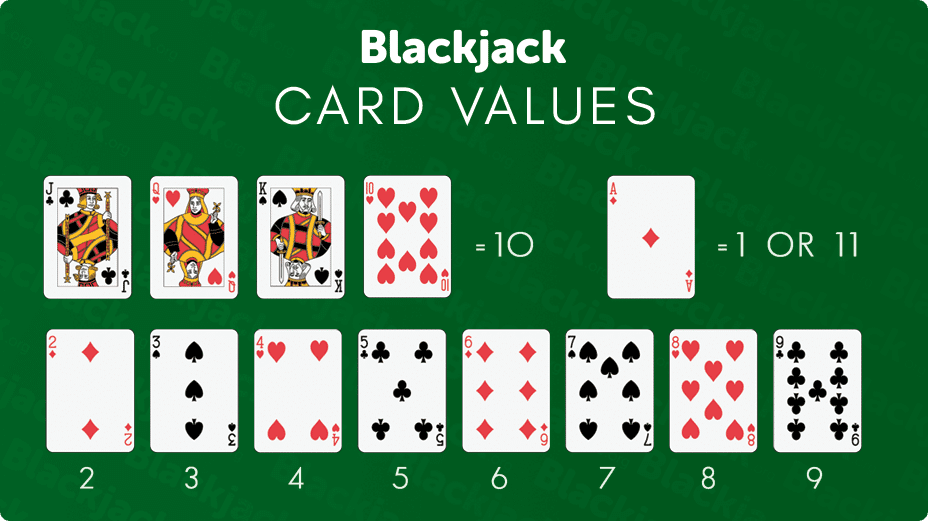
The Blackjack table
The layout of the Blackjack table is quite interesting. The semicircular table can accommodate many players at a time. One of the common Blackjack table layouts sights 7 players at the table. Some tables allow 5 players while others can accommodate up to12 players.
The arrangement of the table is done in a manner that the dealer stands behind the table and the playing chips rack while the players sit opposite to him.
Blackjack Strategy
The basic Blackjack Strategy while playing is to play for every hand and dealer up-card.
If you go by the strategy, you can play your hand by employing any of the options as discussed above. There are three anticipated outcomes:
- If you Stand immediately, it signifies that you were dealt a hand where you should not take more cards as per the basic strategy.
- If you made a hand, it means you took more cards to get to a total of 21 or less.
- If your hand is out of play, you must have either busted or hit or surrendered. The casino reserves an edge on Blackjack because if your hand busts, you instantly lose your wager.
Playing the third hand
Let’s say your hand hasn’t busted and you didn’t even surrender, then this is when the dealer will play his third hand. First, he flips over his face-down card also known as the “hole card”. Then he adds up his two-card hand. If his hand total is 17 or more, he will Stand. In case his hand total is 16 or lesser, he can take an additional Hit card.
Remember, the dealer is not eligible to doubling, splitting or surrendering. Moreover, he is not authorized to decide on how to play his hand. He can only play his hand, in the same way, every time. It is only when he has a 17 with an Ace and 6 value, he can Hit.
This is referred to as the soft 17 hands and based on the casino, this can be counted as 7 also for Ace can be counted as 1 as well. This puts the dealer in an advantage as he can always get a better hand than 17. If the dealer stands on “all 17”, the casino has a better edge. In any case, the dealer has to abide by the casino rules and cannot deviate from it.
Payouts
Once everyone has finished playing their hands at the Blackjack table, it’s time for the payout. So, if the dealer busts, he has to pay 1x the wager to every player hand at the table. If he makes a hand of 17 and your hand is still in play, whoever has the higher hand will win the bet. If you manage a higher hand, the dealer will pay you 1x your bet.
In an occasion where both you and the dealer have the same value as your hand total, it is regarded as a push where you can keep what you had wagered. However, you won’t be paid anything on your wager in this case.
With this, the round concludes and a fresh round begins.
Blackjack Variants
With the emerging popularity of the game, novel variations of Blackjack streamed into the market. Also, new rules have been created to play these games. While some are good, others may not be as beneficial to the players. For instance, the house edge could vary from casino to casino and even if they appear insignificant, they can make a big difference. Let’s look at a few variations of Blackjack and their impact on the house edge.
If you are allowed to double down after splitting pairs, it can lower the house edge by 0.13%. This is an advantage for the player. If you are at a casino that offers Blackjack where you can resplit Aces, should you play? This option cuts the house edge by 0.03% and yes that’s an advantage.
Not everywhere will you find a game where you can draw more than one card on a split Ace and if you walk into one that offers this grab it as it can lower the house advantage by 0.14%.
Note that an early surrender can cut the house edge by 0.624 %. If you are a beginner trying to learn the game, you can save yourself from big losses by surrendering. However, this trick isn’t one that Blackjack pros would like to use. In most cases, the house allows players to surrender 50% of the initial bet even before the dealer checks his hand. This is easy to surrender.
If you surrender late, you will still be giving up half the bet but at this time the dealer would have checked his hand for Blackjack. In this case, the house edge is also lowered. In a single deck Blackjack game it is cut by 0.02% whereas, in a multiple deck game, the house edge is cut by 0.07%.
Did you know that double downs can be limited to hard 10 and hard 11? Well, some casinos don’t allow players to double on totals below 10 or other soft hands. In such cases, you can expect the house advantage to shoot up by 0.28%.
What happens if the dealer hits a soft 17? Well, if he does so instead of standing on all 17s, the house edge is likely to increase by 0.02%. Of Blackjack games that pay 6-5, you can expect the house edge to be increased. Commonly played on a single deck, this can break your bank.
You can enhance your Blackjack skills with refined tips. Blackjack is a quintessential game and comes with certain etiquettes that need to be maintained by players.
Blackjack Basic Strategy and Tips
When playing a game of Blackjack, there could be situations that call for a different course of action. Here we’ve put forth a few such situations that you could encounter at the casino.
Insurance in Blackjack: When the Blackjack dealer has an Ace as his up card, you will see that you are being offered insurance as a side bet. The dealer usually proposes this before any player plays their hand. Either it is insurance or Even Money if you have a Blackjack.
In such a situation, you are allowed to put up a bet amount equal to 50% of your initial bet. You can also propose a lesser amount. This gets paid either as 1x or 2x depending on whether the dealer has a 10 value as his hole card. This means that you will be betting on the dealer’s hand to check whether he has a Blackjack or not.
You can claim 2x or 1x if you win. Most experts recommend players to reject the insurance and even money offer as a basic Blackjack strategy. Players who are skilled at card counting should ideally engage inside bet play.
Remember that once all players who want to buy-in insurance place their wager, the dealer will check his face down card. If the dealer has a 10, he has got a Blackjack! This means you and the other players will have to give away your initial wager. Of those who buy insurance can collect 2 to 1 on their insurance amount.
So what happens if the dealer does not have a 10 as his hole card? He can take any insurance wagers that had been made. The game, however, continues the way it would. In an occasion where a player holds a Blackjack when a dealer has an Ace, you can opt for even money. But, experts guard against this as they say that this is just another calculative approach of what insurance has to offer.
In such a case, if you have taken the money, your Blackjack would not get paid out normally. It will only get 1x the original wager as compared to 3x or 2x that you could otherwise get. This is regardless of whether or not the dealer has a Blackjack.
If you opt-out of even money and the dealer has a Blackjack, your Blackjack will not get paid. Now, let’s say you don’t take even money and the dealer also does not have a Blackjack, in such a case you can collect 3x or 2x your wager. Some experienced players advise that players should not take even money if they aren’t skilled at card counting.
The next one is the non-insurable dealer game of Blackjack. A dealer can have a Blackjack whether he offers insurance or even money does not make a difference. Now, if he has 10 as his upcard, he can check his face down the card before any other player gets to play his hand.
In case the dealer has an Ace in the hole card, it means a Blackjack. He can take all the bets placed on the table barring that of the player who also has a Blackjack. This would just push. Note that insurance is offered only in a situation where the dealer shows an Ace.
If there’s a dead hand, the dealer will turn over his face down card. Then he would sweep all the cards up and set them aside on the discard tray. This happens when all players at the Blackjack table bust before the dealer has the opportunity to play his hand.
There’s no reason to play the dealer’s hand in such a situation as you will only be wasting the cards as the dealer has won by beating the players at the table.
Another deviation in Blackjack can be traced to the side bets. This has emerged as a popular feature in the last few years. In most cases, it is the insurance that is regarded as the side bet. On most Blackjack tables, you’ll find insurance coded as a side bet.
However, this is not the only type of side bet as the innovation-driven industry has been creating Blackjack games powered with other side bets as well. Commonly, you will be required to place a bet on the side bet at the same time as you place your main wager.
Other side bets could include:
- Betting on receiving a pair as the first 2 cards,
- Betting on if your card will match the dealer’s card
- Betting on making a poker hand with the dealer’s face-up card.
- Betting on whether the dealer will bust.
Every side bet comes with a different set of procedures and pay tables. All you need to know is that these side bets are not an integral part of your actual Blackjack game but can impact the regular procedure of the game that you play. Most casinos offer these side bets as they bring them a good advantage. Blackjack pros warn against staking inside bets, instead suggest learning the art of card counting.
Blackjack Game Rules Variations
Your game can be affected by the different rules that apply. It is said that “not all Blackjack games are created equal”. The difference is usually in terms of the odds and also in how they favor the player. Here’s we’ve discussed a few rules and how they can impact the odds at play.
- Let’s take ‘doubling after splitting’ for instance. This allows players to double down on a hand that they have split. While some casinos allow this, others don’t. At casinos that you to double after splitting, you can consider yourself lucky as it cuts on the house advantage and enhances the player edge.
- The second one is ‘re-splitting the aces’. If your casino allows you to split your Aces even after you’ve already spilt it once before, you have a reason to celebrate. For instance, you have a pair of Aces and received another as your following card; you will be allowed to split to a third hand or up to four hands. One thing that the casinos know is that the Ace is the most powerful card in the game of Blackjack and can be used in two different ways. That’s why most of them will not allow either doubling after splitting an Ace or taking additional cards so that the advantage is lesser for the players.
- ‘Early surrender’ is addressed as an early one because it was to be made before a normal surrender. In the US, however, most casinos considered early surrender as an obsolete rule because it is similar to the regular surrender rule where the player can surrender to the dealer before he checks for a Blackjack or offers insurance. The strategy was considered to offer players a small edge. Moreover, players could avoid card counting yet have an advantage.
- 6 to 5 Blackjacks – In most casinos that offer Blackjack games, you’ll find they reduce the payouts down to 6 to 5 from 3 to 2. This is done to increase the house edge and siphon money from the player’s pockets. Blackjack veterans say that it can dissolve the pros of card counting. It is suggested that you read the rules before placing your wager on the Blackjack table.
- Many casinos use the ‘continuous shuffling machines’ for their Blackjack games. This machine usually shuffles cards in the course of the game. Instead of putting the cards in the discard tray, you will find the dealers use this machine to put the used cards. Here they have continuously shuffled automatically. At casinos where these machines are employed, card counting could become a useless strategy, thereby making it difficult for the player to optimize the odds at winning.
- Single deck and multiple-deck Blackjack – Do you know that adding a deck to the game of Blackjack increases the house edge. A Blackjack game played with 6 decks will have a higher house advantage than one player with 2 card decks despite all other conditions being the same. Other conditions being equal are more theoretical than practical. In a Blackjack game played with one deck, you might not able to double after splitting. Also, the casino might not allow re-splitting the aces plus there will be 6 to 5 Blackjacks. In a game with multiple decks such as 8 decks, the casino might allow doubling, re-splitting and also have only 3 to 2 Blackjacks. Additionally, the house edge would also be lesser.
- Another variation is that of the ‘deck penetration’. This is expressed as a percentage of the cards that have been dealt out over the deck or the shoe. The cards that are dealt towards the end have a cut-card inserted somewhere in the shoe. As and when this cut-card is dealt during the game, it indicates that the shoe is almost out of cards and that the dealer needs to shuffle the cards. Most casinos cut off more cards so that their profitability from the game is not lost to a card counter although a quarter of the card deck can efficiently suffice for a Blackjack round. Players who count their cards can make use of the girth of shoe or deck penetration to either improve or lose their winnings chances in a game of Blackjack.




